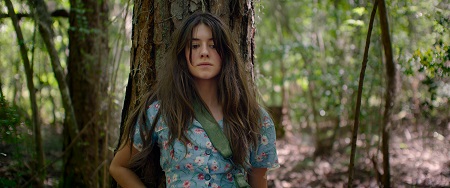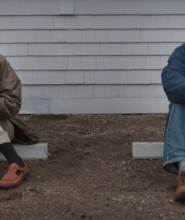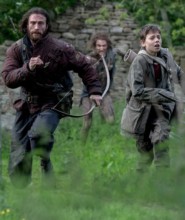
“Where the Crawdads Sing” – Interview with Olivia Newman
by Sara Michelle Fetters - July 15th, 2022 - Interviews
Overcoming Obstacles
Making Where the Crawdads Sing with director Olivia Newman
Based on the best-selling novel by Delia Owen, Where the Crawdads Sing is a courtroom thriller primarily set in the North Carolina marshlands of the 1950s and ’60s. The story follows Kya Clark (Daisy Edgar-Jones), a self-educated loner nicknamed “marsh girl” by the judgmental townsfolk who don’t understand how she could live by herself in dangerous isolation out among the wildlife.
After she is arrested for murder, the young woman’s story is told in delicate flashback, starting with her abandonment by her family while still a youngster and going all the way through her romances with a pair of young men, the dashing Tate Walker (Taylor John Smith) and the cocksure Chase Andrews (Harris Dickinson). Kya’s friendship with riverside store owners Jumpin’ (Sterling Macer Jr.) and Mabel (Michael Hyatt) is chronicled, as the pair become de facto parental figures even though their help could put them in jeopardy with local authorities.
The film is a melodrama in the Douglas Sirk school, crossed with the visual sensibilities of a Jane Campion effort in the vein of The Piano or Bright Star. Granted, while Where the Crawdads Sing never rises to those lofty heights, it is still a strong, character-driven delight that wears its emotional sensibilities on its sleeve. Kya’s journey is empathetically empowering, and while the outcome of her story is never in doubt, getting there remains something special all the same.
I had the chance to speak with director Olivia Newman over the phone about her new film. The following are the edited transcripts of our all-too-brief conversation:
Sara Michelle Fetters: What was it about Delia Owen’s novel and, in turn, what was it about Lucy Alibar’s script that captured your attention and made you want to make this film?
Olivia Newman: The character of Kya was just fascinating to me. I’d never really read a character quite like her when I read the book. She sort of walks that line. She’s not completely wild, but she’s also not completely socialized. It’s somewhere in between, and I love that complexity about her.
I also loved her really unique perspective. She’s sort of an outsider to this society that has rejected her. Through her, you’re able to look at this very specific time period through that outsider lens, experience what it is to be ostracized and overlooked and underestimated. I thought Delia did an amazing job of capturing this really unique experience in the book.
When I read Lucy’s script, it felt like such a lyrical adaptation of a book that was already so poetic. Lucy is somebody who’s from the South and really understood the heart of this story so well. I had also loved Beasts of the Southern Wild, so I was excited to collaborate with her.
SMF: What was the collaboration like between the two of you once you got your hands on the script and you started working together to get this film made?
ON: We went through several drafts where we just sort of tried to crack what the structure for what the movie needed to be. Lucy had done such an amazing job of being so faithful to the book, but we knew that we needed to restructure it a bit for the film version. We worked on several drafts together and came up with this restructuring where we wanted to be with Kya as much as possible. That’s why we moved the arrest to the very [start], so that you’re with her in the courtroom throughout the present storyline. Then, whenever we flash back, we’re still with Kya, as we’re watching her survival and her romances and the murder mystery all unfold in the past.
SMF: Melodramas like this, they’re so hard to get right. You’re either going to go into Douglas Sirk territory — who is sort of the master at doing something like this and making it still feel real yet still having those big, broad emotions — or you’re going to go in the opposite direction, where the emotions are too broad and the audience is going to turn off on you. They’re going to feel like it’s all false. That it’s too facile.
Where do you find the balance to maintain the emotional resonance that is inherent to a good melodrama, but without letting it drop into treacle and into oversentimentality?
ON: Good question. I think for me it’s about staying truthful to what is happening emotionally. Daisy gives such a beautiful performance, and we were so specific about our compositions, lighting, and palette, how we wanted to support what was happening emotionally with our cinematography, that it’s really about not pushing something that doesn’t need to be pushed. The camera and the performance were already doing the work so, for me, it’s about believing that when I’m watching. Do I feel what Kya’s feeling? Am I experiencing it with her? That was always the goal.
Director of photography Polly Morgan and I drew a lot of inspiration from Terrence Malick and from Jane Campion. I think those are both filmmakers who use the landscape to create emotionality and to create another character in their movies with the landscape. I believe every moment of emotion in their films. Those filmmakers were real touchstones for us.
SMF: I love that you bring up Jane Campion, only because I could feel some similarities, visually and structurally, to The Piano, the way you so expressionistically portrayed the landscape and had it become a character that connected so intimately with Kya. How hard was it for you and Polly to do that?
ON: Whenever we were picking locations, we always started from the place of what is happening emotionally in this moment. There are times where the marsh feels like a place that is safe and free for Kya. There are times where the marsh feels overwhelming and scary.
When she gets lost as a young girl, a lot of thought went into how do we capture that feeling of being overwhelmed by this expanse? Then there’s times where she’s standing on the edge of the water and looking out, and that wide shot suddenly feels incredibly lonely. We always went about shooting her against that landscape, always came from a place of what is happening emotionally and how do we get that on the screen through our framing and through our camera movement? How will that support the brilliant performances that we were getting?
SMF: Speaking to those performances, you give Daisy a lot of support by surrounding her with folks like David Strathairn, Michael Hyatt, and Sterling Macer Jr. But were you at all trepidatious about trusting a youngster like this to just carry your film? Was there ever any worry on your part that no actor, let alone a relative newcomer like Daisy, was going to be able to rise to the challenge?
ON: I was nervous about it before I had cast Daisy. Once I had Daisy, all the fear was gone. Not only is she an incredibly capable actress, in my mind there’s nothing Daisy can’t do. She’s kind of the ultimate collaborator. We were conversing and sharing material. I was sending her books and we were sending her music playlists. We put together research packets for her to be able to immerse herself in the time period.
The collaboration began months before we were in Louisiana together. Once we were there, we worked with a movement coach to really capture Kya’s physicality. Daisy’s in this line of work because she loves the craft and she loves the work. I knew from our first meeting, before she even had auditioned, just from the type of questions that she was asking and the way that she was thinking about the character, that this was a very serious actor. Much wiser than her years.
I like to say Daisy is an old soul, and I learned so much from working with her. It was truly an awe-inspiring collaboration.
SMF: There were things going on in the world when you were shooting the movie that paralleled many of the themes that were happening in this story. But none of you could have foreseen where we would be in this moment. When you look at the film and what it’s about, look at Kya, what she goes through, and what she stands for, especially for young women, how important is her story right now? Especially with everything that’s just transpired in regards to the Supreme Court?
ON: Oh my gosh1 I think it is incredibly timely. I mean, one of the themes of the story is about women not having a place to turn for justice. The story is set during a time when there was absolutely no legal recourse for a woman who was the victim of domestic violence, and that is why Kya’s mother left and had a breakdown. There was nowhere for her to go for help.
Subsequently, there’s nowhere for Kaya to turn, so she has to figure out a way to save herself. It’s heartbreaking to think that we are in this position, and that women are going to be finding ways to save themselves again. If the law isn’t there to protect us, then we’re going to do it ourselves. It’s a really sad moment.
I think what I find inspiring about a character like Kya is that, in the face of so many challenges, this is a woman who gets knocked down over and over again but who picks herself back up and figures out how to survive. She figures out how to save herself. That’s inspiring.
Believe me, I knew three years ago that this was exactly where we were going to end up. It was not a surprise to me. I could see it the minute the elections happened in 2016, I knew where we were headed.
SMF: With that in mind, while the book has been and continues to be massively popular, just by the nature of being a motion picture, more people are going to become acquainted with this story now than ever before. What do you hope audiences take away from Kya’s story? What do you hope they are thinking about when her journey comes to an end?
ON: I think that we are literally living through a moment where we need hope. My wish is that people take away from this story some hope that there’s always a way to survive and that we are strong as a human species. We are more resilient than we know, especially when we’re faced with life’s greatest obstacles.
– Interview reprinted courtesy of the SGN in Seattle






